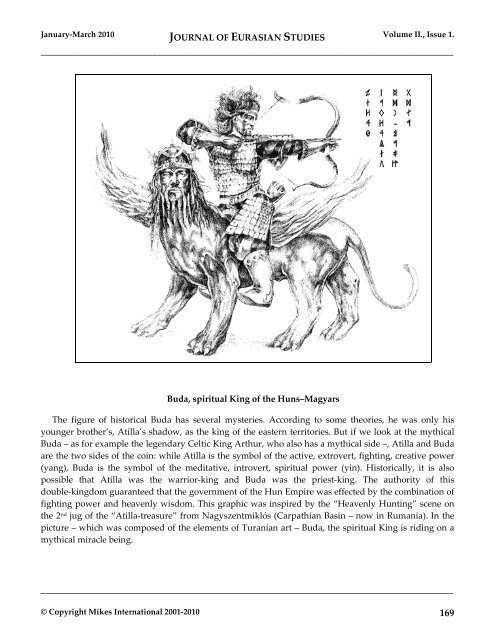EurasianStudies_0110..
EurasianStudies_0110..
EurasianStudies_0110..
You also want an ePaper? Increase the reach of your titles
YUMPU automatically turns print PDFs into web optimized ePapers that Google loves.
January-March 2010 JOURNAL OF EURASIAN STUDIES Volume II., Issue 1.<br />
_____________________________________________________________________________________<br />
Buda, spiritual King of the Huns–Magyars<br />
The figure of historical Buda has several mysteries. According to some theories, he was only his<br />
younger brother’s, Atilla’s shadow, as the king of the eastern territories. But if we look at the mythical<br />
Buda – as for example the legendary Celtic King Arthur, who also has a mythical side –, Atilla and Buda<br />
are the two sides of the coin: while Atilla is the symbol of the active, extrovert, fighting, creative power<br />
(yang), Buda is the symbol of the meditative, introvert, spiritual power (yin). Historically, it is also<br />
possible that Atilla was the warrior-king and Buda was the priest-king. The authority of this<br />
double-kingdom guaranteed that the government of the Hun Empire was effected by the combination of<br />
fighting power and heavenly wisdom. This graphic was inspired by the “Heavenly Hunting” scene on<br />
the 2 nd jug of the “Atilla-treasure” from Nagyszentmiklós (Carpathian Basin – now in Rumania). In the<br />
picture – which was composed of the elements of Turanian art – Buda, the spiritual King is riding on a<br />
mythical miracle being.<br />
_____________________________________________________________________________________<br />
© Copyright Mikes International 2001-2010 169

















